Are you looking to shed some pounds without feeling hungry or tired all day? A 1000 calorie healthy eating plan might be exactly what you need.
It’s designed to help you lose weight safely while giving your body the nutrients it needs. Imagine feeling energized, satisfied, and confident in your food choices every single day. You’ll discover simple, tasty meals that fit into this plan and tips to make sticking to it easier than ever.
Ready to take control of your health and see real results? Keep reading—you’re closer than you think.
Benefits Of A 1000 Calorie Plan
A 1000 calorie healthy eating plan offers clear benefits for people aiming to lose weight safely and steadily. It creates a calorie deficit that helps burn fat while supporting essential body functions. This plan encourages mindful eating and better food choices.
Choosing a 1000 calorie plan can improve energy levels and mood. It helps control hunger by including nutrient-rich foods. The plan is simple to follow and fits into daily routines easily.
Supports Weight Loss
This plan reduces daily calorie intake, leading to gradual weight loss. It targets fat stores while preserving muscle mass. Weight loss can improve health markers like blood pressure and cholesterol.
Promotes Nutrient Intake
A 1000 calorie plan focuses on nutrient-dense foods. It ensures the body receives vitamins and minerals despite lower calories. Balanced meals support overall health and prevent nutrient deficiencies.
Improves Blood Sugar Control
Eating smaller, balanced meals stabilizes blood sugar levels. This helps reduce cravings and energy crashes. Better blood sugar control lowers the risk of diabetes complications.
Enhances Digestive Health
The plan encourages fiber-rich foods like fruits and vegetables. Fiber promotes healthy digestion and regular bowel movements. Good digestion supports nutrient absorption and gut health.
Boosts Mental Clarity
Consuming balanced meals with protein and healthy fats supports brain function. Stable blood sugar prevents brain fog and fatigue. Mental clarity improves focus and productivity during the day.
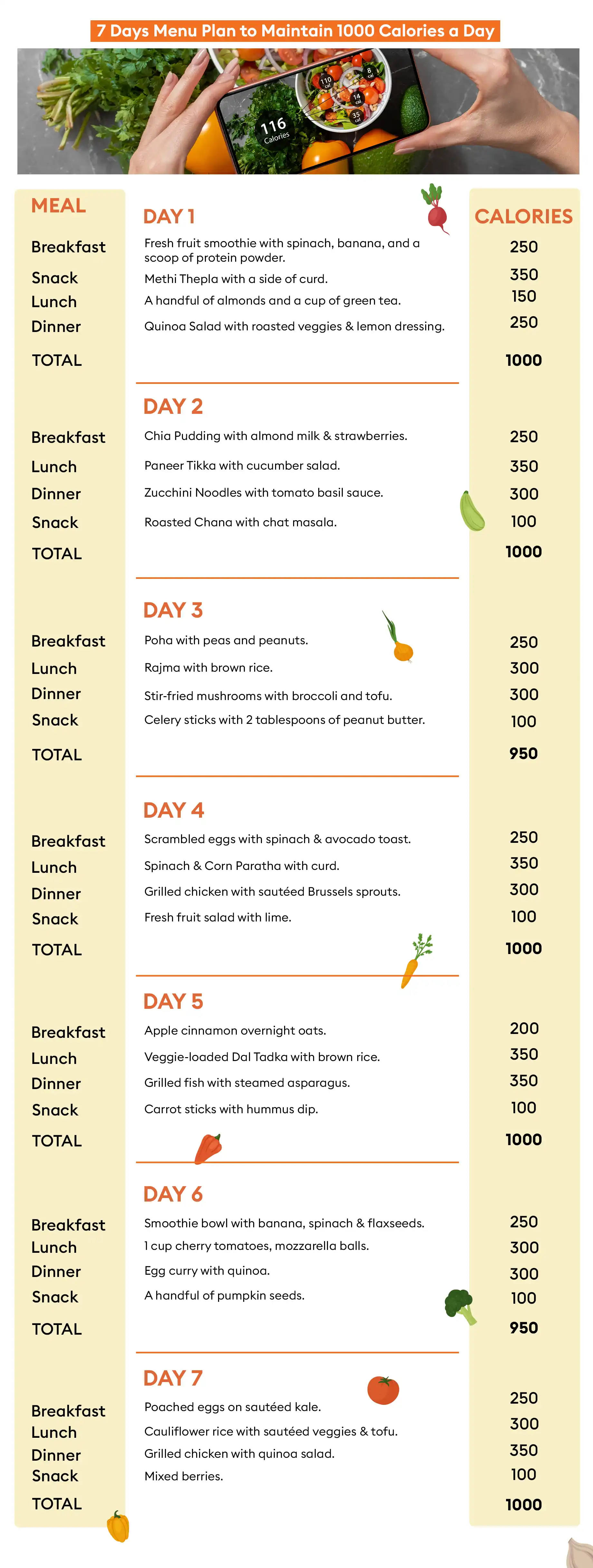
Credit: vlcc.com
Key Nutrients To Include
Choosing the right nutrients is important for a 1000 calorie healthy eating plan. Each nutrient plays a role in keeping the body strong and full of energy. This plan needs careful balance to support health and avoid feeling weak or tired.
Focus on foods that provide essential proteins, healthy fats, carbohydrates, vitamins, and minerals. These nutrients work together to fuel your body properly in a low-calorie diet.
Proteins For Muscle And Satiety
Proteins help build and repair muscles. They keep you full longer, reducing hunger between meals. Good sources include lean meat, fish, eggs, beans, and low-fat dairy. Including enough protein aids in maintaining muscle mass during weight loss.
Healthy Fats For Energy
Healthy fats give the body long-lasting energy. They support brain health and help absorb vitamins. Choose fats from nuts, seeds, avocado, and olive oil. Avoid trans fats and limit saturated fats to protect heart health.
Carbohydrates For Fuel
Carbohydrates provide quick energy for daily activities. Opt for whole grains, fruits, and vegetables. These choices offer fiber, which helps digestion and keeps you feeling full. Limit refined sugars and processed carbs to maintain stable energy levels.
Vitamins And Minerals Essentials
Vitamins and minerals support many body functions. They boost the immune system and help bones stay strong. Include colorful fruits and vegetables to get a wide range of these nutrients. Iron, calcium, vitamin C, and potassium are especially important on a low-calorie plan.
Sample Meal Ideas
Eating 1000 calories a day can be balanced and nutritious. Choosing the right foods is key to staying healthy and full. Below are sample meal ideas that fit this plan well. These meals provide energy and important nutrients. They also keep your taste buds happy.
Breakfast Options
Start with a bowl of oatmeal topped with fresh berries. Add a spoon of honey for sweetness. Or try a smoothie with spinach, banana, and low-fat yogurt. A boiled egg with a slice of whole-grain toast also works well.
Lunch Choices
Enjoy a mixed salad with grilled chicken, cherry tomatoes, and cucumbers. Use a light vinaigrette dressing. Another choice is a whole-wheat wrap filled with turkey, lettuce, and avocado slices. Pair it with a small apple for extra fiber.
Dinner Suggestions
Try steamed fish with a side of roasted vegetables like carrots and broccoli. Brown rice or quinoa adds good carbs. A vegetable stir-fry with tofu and a light soy sauce is tasty and filling. Keep portions moderate to stay within calories.
Snacks And Small Bites
Snack on a handful of almonds or a small cup of low-fat yogurt. Fresh fruit such as an orange or a few strawberries works well too. Carrot sticks with hummus make a crunchy, satisfying snack. Choose light, simple snacks to avoid extra calories.
Tips For Staying Full And Satisfied
Staying full and satisfied on a 1000 calorie healthy eating plan can be challenging. Eating small amounts means choosing foods that keep hunger away longer. Smart choices help avoid cravings and energy drops.
Here are simple tips to feel full and enjoy your meals without overeating. These strategies work well for low-calorie diets.
High-fiber Foods
Fiber slows digestion and keeps you feeling full. Vegetables, fruits, and whole grains are great fiber sources. Beans and lentils fill the stomach without adding many calories. Fiber also supports digestion and overall health.
Choose foods like broccoli, carrots, apples, and oats. These help stretch your meals and reduce hunger. Eating fiber-rich foods makes small meals more satisfying.
Hydration Strategies
Drinking water helps control hunger. Sometimes thirst feels like hunger. Sip water before and during meals to feel fuller faster. Herbal teas or sparkling water add variety without calories.
Aim to drink at least 8 cups of water daily. Staying hydrated helps digestion and energy. Avoid sugary drinks that add calories without filling you up.
Balanced Meal Timing
Eating at regular times prevents extreme hunger. Skipping meals leads to overeating later. Spread your calories over three small meals and snacks. This keeps blood sugar steady and hunger low.
Try not to wait too long between meals. A balanced schedule helps your body adapt and feel satisfied. Consistency in meal timing supports weight control and energy.
Common Mistakes To Avoid
A 1000 calorie healthy eating plan can be effective when done right. Many people make common mistakes that reduce its benefits. Avoiding these errors helps keep energy levels stable and supports overall health.
Careful planning is key. Small errors can lead to nutrient gaps or feelings of hunger. Knowing what to avoid makes this low-calorie plan safer and easier to follow.
Skipping Meals
Skipping meals can slow down your metabolism. It may cause overeating later in the day. Regular meals help maintain energy and control hunger. Eat small, balanced meals throughout the day for steady fuel.
Neglecting Nutrient Variety
Eating the same foods limits nutrient intake. Variety ensures you get enough vitamins and minerals. Include fruits, vegetables, proteins, and whole grains. This balance supports your body’s needs on a low calorie plan.
Overemphasizing Processed Foods
Processed foods often contain added sugars and unhealthy fats. They lack essential nutrients your body needs. Focus on fresh, whole foods instead. This choice improves health and helps you feel fuller longer.

Credit: slimmingsolutions.com
Adjusting The Plan For Individual Needs
Adjusting a 1000 calorie healthy eating plan to fit your unique needs is important. Everyone’s body and lifestyle differ. A plan that works for one person might not suit another. Tailoring the plan helps you stay healthy and feel good.
Small changes can make a big difference. Focus on what fits your daily routine, health, and taste. This approach keeps your diet balanced and enjoyable.
Considering Activity Levels
Activity levels impact how many calories your body needs. If you exercise often, you might need more than 1000 calories. Less active people may find 1000 calories enough or even too much. Adjust food portions based on your daily movement. This helps maintain energy and avoid tiredness.
Account For Medical Conditions
Some medical conditions affect how your body uses food. Diabetes, thyroid issues, or digestive problems need special care. Talk to a doctor before starting any low-calorie plan. They can suggest safe changes that support your health. Avoid cutting calories too low if you have health concerns.
Personal Taste Preferences
Eating foods you like makes sticking to the plan easier. Choose fruits, vegetables, and proteins you enjoy. Swap items that do not appeal to you with similar healthy options. This keeps meals satisfying and prevents boredom. Variety helps you stay on track long term.
Tracking Progress And Staying Motivated
Tracking progress and staying motivated are key to success in a 1000 calorie healthy eating plan. Keeping an eye on your progress helps you stay focused. Motivation fuels your commitment and keeps you going on tough days.
Using Food Journals
Food journals help you record everything you eat daily. Writing down meals makes you more aware of your choices. It shows patterns and helps spot areas for improvement. Use a notebook or an app to track your calories. This simple step keeps you honest and on track.
Setting Realistic Goals
Set small, clear goals that you can reach easily. Realistic goals build confidence and prevent frustration. For example, aim to lose one pound a week or try new healthy recipes. These goals guide your efforts and make progress steady. Adjust goals as you improve to stay challenged.
Celebrating Small Wins
Recognize every success, no matter how small. Finishing a week on plan or cooking a healthy meal counts. Celebrating boosts your mood and motivation. Treat yourself with something simple like a walk or a favorite hobby. These rewards keep your spirit high and your goals in sight.

Credit: www.kaya.in
Frequently Asked Questions
What Foods Are Best For A 1000 Calorie Healthy Eating Plan?
Choose lean proteins, fresh vegetables, fruits, whole grains, and healthy fats for balanced nutrition.
Can A 1000 Calorie Diet Provide Enough Daily Nutrients?
Yes, if meals are well-planned with nutrient-rich foods to meet essential vitamins and minerals.
How Often Should I Eat On A 1000 Calorie Plan?
Eat 3 small meals and 1-2 healthy snacks to keep energy steady and hunger controlled.
Is A 1000 Calorie Diet Safe For Weight Loss?
It can be safe short-term, but consult a doctor before starting any low-calorie diet.
Conclusion
A 1000 calorie healthy eating plan can support weight loss safely. Choose whole foods like fruits, vegetables, lean proteins, and whole grains. Drink plenty of water each day. Plan meals ahead to avoid unhealthy choices. Listen to your body’s hunger and fullness signals.
Small changes lead to better health over time. Stay consistent and patient with your progress. Enjoy food while caring for your body. This plan works best with balance and variety. Keep your goals in mind and stay positive. Healthy eating is a journey, not a quick fix.

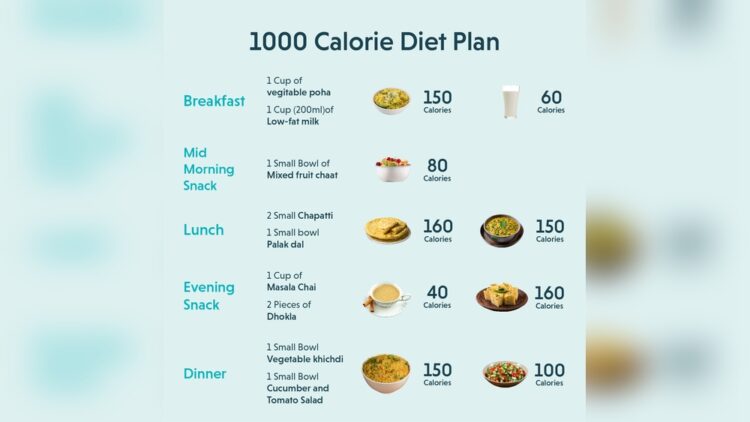

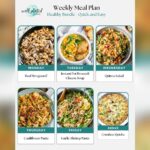
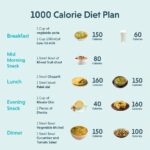




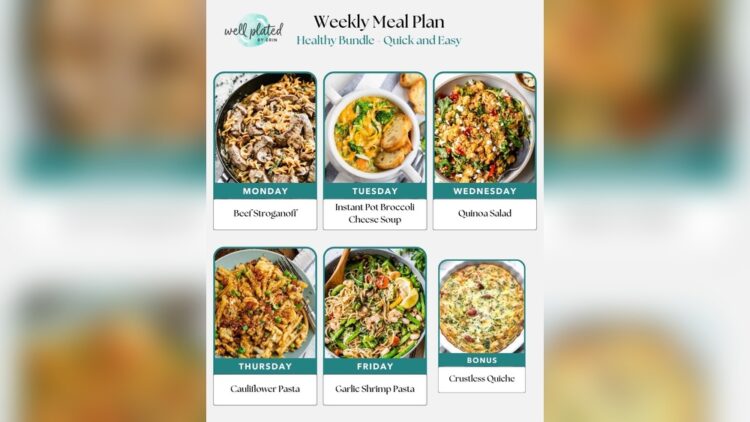

Leave a Reply